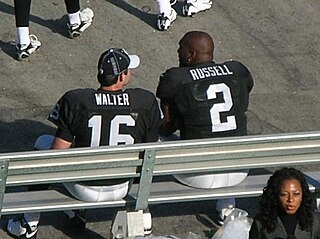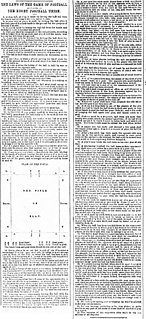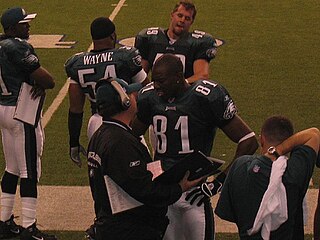
Canadian football is a sport played in Canada in which two teams of 12 players each compete for territorial control of a field of play 110 yards (101 m) long and 65 yards (59 m) wide attempting to advance a pointed oval-shaped ball into the opposing team's scoring area.
A drop kick is a type of kick in various codes of football. It involves a player dropping the ball and then kicking it after it bounces off the ground.

The end zone is the scoring area on the field, according to gridiron-based codes of football. It is the area between the end line and goal line bounded by the sidelines. There are two end zones, each being on an opposite side of the field. It is bordered on all sides by a white line indicating its beginning and end points, with orange, square pylons placed at each of the four corners as a visual aid. Canadian rule books use the terms goal area and dead line instead of end zone and end line respectively, but the latter terms are the more common in colloquial Canadian English. Unlike sports like association football and ice hockey which require the ball/puck to pass completely over the goal line to count as a score, both Canadian and American football merely need any part of the ball to break the vertical plane of the outer edge of the goal line.

A try is a way of scoring points in rugby union and rugby league football. A try is scored by grounding the ball in the opposition's in-goal area. Rugby union and league differ slightly in defining 'grounding the ball' and the 'in-goal' area.
Dead ball is a term in many ball sports in which the ball is deemed temporarily not playable, and no movement may be made with it or the players from their respective positions of significance. Depending on the sport, this event may be quite routine, and often occurs between individual plays of the game.

The "sidelines" are the white or colored lines which mark the outer boundaries of a sports field, running parallel to each other and perpendicular to the goal lines. The sidelines are also where the coaching staff and players out of play operate during a game. The area outside the sidelines is said to be out of bounds. The term is predominantly in use in American football, Canadian football, field lacrosse and basketball.

A throw-in is a method of restarting play in a game of football when the ball has exited the side of the field of play. It is governed by Law 15 of The Laws Of The Game.

Like most forms of modern football, rugby league football is played outdoors on a rectangular grass field with goals at each end that are to be attacked and defended by two opposing teams. The rules of rugby league have changed significantly over the decades since rugby football split into the league and union codes. This article details the modern form of the game and how it is generally played today, however rules do vary slightly between specific competitions.
Speedball is a fast-paced sport that combines many aspects of other sports. Points are scored by throwing or kicking the ball into the opposing goal. It is played with two teams of five or more, each with one goalie on a basketball court or soccer field.

A comparison of American football and rugby union is possible because of the games' shared origins, despite their dissimilarities.
A comparison between American football and rugby league is possible because of their shared origins and similar game concepts. Rugby league is arguably the most similar sport to American football after Canadian football: both sports involve the concept of a limited number of downs/tackles and scoring touchdowns/tries takes clear precedence over goal-kicking.

Rugby union is a contact sport that consists of two teams of fifteen players. The objective is to obtain more points than the opposition through scoring tries or kicking goals over eighty minutes of playing time. The play is started with one team drop-kicking the ball from the halfway line towards the opposition. The rugby ball can be moved up the field by either carrying it or kicking it. However, when passing the ball it can only be thrown laterally or backward. The opposition can stop players moving up the field by tackling them. Only players carrying the ball can be tackled and once a tackle is completed the opposition can compete for the ball. Play continues until a try is scored, the ball crosses the side line or dead-ball line, or an infringement occurs. After a team scores points, the non-scoring team restarts the game at the halfway with a drop kick toward the opposition. The team with the most points at the end wins the game.
This list of rugby league terms is a general glossary of the terminology used in the sport of rugby league football. The sport has accrued a considerable amount of jargon to describe aspects of the game. Many terms originate from the Laws of the Game. A number of aspects of the game have more than one term that refers to them. Different terms have become popularly used to describe an aspect of the game in different places with notable differences between the northern and southern hemispheres.

The rugby league playing field, also referred to as a pitch or paddock, is the playing surface for the sport of rugby league football and is surfaced exclusively with grass.
A comparison of Canadian football and rugby union is possible because of the games' shared origins, despite their dissimilarities.

In gridiron football, a punt is a kick performed by dropping the ball from the hands and then kicking the ball before it hits the ground. The most common use of this tactic is to punt the ball downfield to the opposing team, usually on the final down, with the hope of giving the receiving team a field position that is more advantageous to the kicking team when possession changes. The result of a typical punt, barring any penalties or extraordinary circumstances, is a first down for the receiving team. A punt is not to be confused with a drop kick, a kick after the ball hits the ground, now rare in both American and Canadian football.

The laws of Rugby Union are defined by World Rugby and dictate how the game should be played. They are enforced by a referee, generally with the help of two assistant referees.

Futsal began in the 1930s in South America as a version of association football, taking elements of its parent game into an indoor format so players could still play during inclement weather. Over the years, both sports have developed, creating a situation where the two sports share common traits while also hosting various differences.












